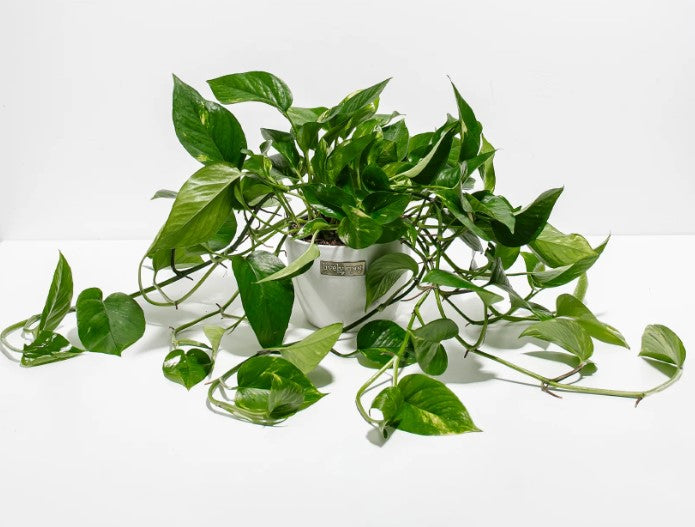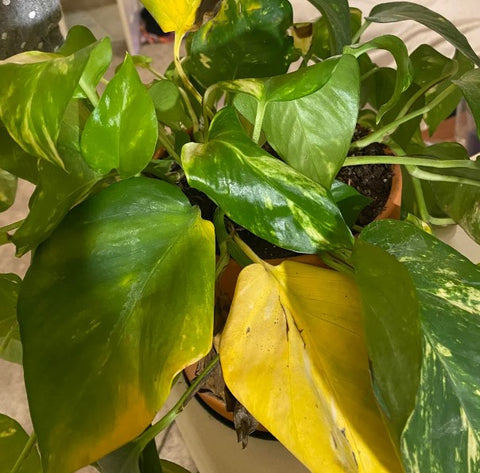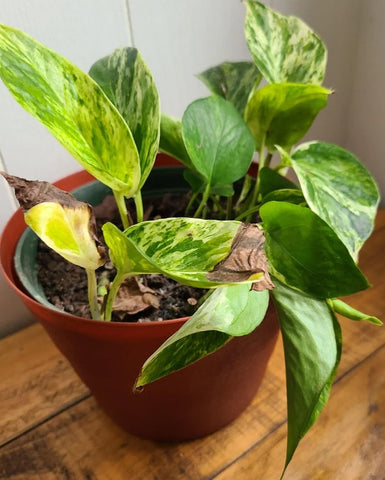Fixing Golden Pothos Yellow Leaves: A Complete Guide
Golden Pothos is probably one of the easiest plants to grow in an indoor setting due to its low-maintenance requirements. Belonging to the Araceae plant family, it's visually appealing, fast-growing, and has a reputation for being impossible to kill, among its many benefits! However, this gorgeous air-purifying plant is sometimes prone to several leaf-related problems, such as yellowing, curling or brown leaves, black spots on foliage, or a droopy appearance.
In this guide, we'll identify the underlying causes behind these common golden pothos problems and share with you some simple solutions to help you fix them and revive your plant’s vibrant look.
About Golden Pothos

Golden pothos, also known by its Latin name Epipremnum aureum, is a hardy evergreen plant from the remote islands in the South Pacific. Because of the attractive way its thick, glossy, and heart-shaped variegated leaves drape around the stem, it makes a good choice for a hanging plant in indoor gardens.
Like a jade plant, golden pothos doesn't need much water to thrive and can happily live in low-light conditions for several weeks. This is why it has a reputation for being impossible to kill, giving it the nickname Devil's Ivy.
Also, note that you should keep it out of reach from pets and small children, as the golden pothos plant is toxic to cats, dogs, and people.
Are All Golden Pothos Variegated?
Yes, the golden pothos is a variegated variety, with green leaves boasting yellow or white streaks and specks, which are more vivid if the plant is grown in bright, indirect light. Marble Queen, Pearl Jade, and Silver Splash are some widely available variegated pothos varieties.
Can Golden Pothos Be All Green?
The variegation of golden pothos can be affected, giving it an all-green appearance. This primarily happens, due to a lack of sufficient sunlight exposure, which results in the leaves losing their patches of golden or yellow color.
Let's look at the other common leaf issues with golden pothos and their causes, and find out how you can fix them.
Golden Pothos Leaves Turning Yellow: Causes & Solutions

There isn't just one but multiple causes behind your golden pothos leaves turning yellow.
- Overwatering your golden pothos highly contributes to its leaves turning yellow. Overly wet soil causes root rot, which, in turn, causes yellowing foliage.
- Poor drainage, which leads to waterlogged roots, can also trigger yellowing in your plant's leaves.
- Golden pothos prefers partial shade or indirect sunlight. Any exposure to direct light can make its leaves turn yellow.
- If you've recently relocated or repotted your golden pothos, it may respond poorly to these changes, resulting in some of its vibrant green leaves becoming yellow.
- Excess fertilizer use can also cause the leaves to turn yellow by affecting the soil health.
- Lastly, it's normal for the leaves on the pothos plant to turn yellow, due to the natural aging process.
How Do I Fix Yellow Leaves on My Golden Pothos?
Preventing and fixing your golden pothos’ yellow leaf problem is pretty straightforward. Ensure it only receives indirect sunlight, and be mindful when watering your plant. Always let the top 2-inch of the soil dry between waterings and provide good soil drainage.
Avoid feeding your pothos plant too much fertilizer, too. It's important to keep your golden pothos away from vents or any area of your home with a draft, as temperature fluctuations are also bad for your plant's variegated leaves. Lastly, trim off the wilted, yellow foliage, as it won’t turn green again.
Why Are My Golden Pothos Leaves Turning Brown?

If your golden pothos’ leaves are turning brown or black, or developing brown tips and edges or small spots, the cause could be exposure to high temperatures and harsh sunlight, fertilizer overuse, overwatering, and several possible diseases. Poor air circulation and fungus issues can also turn its green leaves brown.
How Do You Get Rid of Brown Spots on Golden Pothos?
To get rid of brown spots on your golden pothos, it’s vital to keep the plant in indirect, filtered sunlight. Water your plant only when the soil feels dry to the touch. Remember, overwatering is the root cause of golden pothos leaves turning brown.
Also, check for sufficient drainage holes at the bottom of the pot to prevent waterlogging. Prune any dead, damaged, or diseased leaves on your golden pothos to let the healthy ones receive sufficient nutrients from the soil. Last but not least, regularly inspect your plant for signs of pests and fungus to keep it disease-free.
Golden Pothos Leaves Curling: Reasons and How to Fix It?
Curling leaves is another issue with almost every variety of pothos, and multiple factors can cause this.
- If you're underwatering this houseplant, its leaves will likely start curling to preserve moisture.
- Overwatering your golden pothos does no good, either. It leads to root rot, making it difficult for the roots to absorb sufficient nutrients and moisture from the soil. As a result, the leaves start to curl and wilt.
- Sudden temperature changes can shock your golden pothos, resulting in curled leaves.
- Varying bacterial and fungal diseases can also induce curling in leaves.
Golden Pothos Curling Leaves: Solutions
The best solution to stop your golden pothos’ leaves from curling is to ensure the right sunlight conditions and watering frequency. Also, being a tropical plant, the golden pothos plant enjoys consistent temperatures between 70°F and 90°F to stay happy and healthy.
Last but not least, refrain from overfertilizing your plant to avoid plant toxicity. Instead, the best practice is to feed it an organic fertilizer once a month in the spring and summer months.
Golden Pothos Leaves Drooping: Causes & Fixes

If you find your healthy golden pothos’ leaves drooping, some possible reasons may include dry soil, less humidity, unsteady temperatures, poor root health, and lack of sufficient nutrients.
Repotting your golden pothos can sometimes lead to transplant shock and put the plant under stress, causing the leaves to droop or fall off.
How Do You Fix Droopy Pothos?
Fixing a droopy pothos involves increasing the humidity levels around it, either by misting it or using a humidifier. Water your plant sufficiently and keep the soil moist but not soggy until it regains its vibrancy and the leaves perk up.
Rule out any root rot and disease issues by examining your plant closely for sure signs. If necessary change the soil by repotting your golden pothos in a new container with a fresh potting mix. Don’t forget to check and clean the roots in the process.
How Do You Make Golden Pothos Happy: Care Tips
You can keep your golden pothos happy by preventing common problems like yellowing, browning, drooping, curling, and other issues. Additionally, below are some care tips that would help your plant thrive:
- Place your golden pothos plant near an east- or north-facing window so that it gets consistent indirect light.
- Use clean, filtered bottled water to quench your plant's thirst. Rainwater is also a good option.
- Maintain the optimum temperature range of 70°F to 90°F, avoiding drafts.
- Avoid chemical-based fertilizers and only use organic plant food to feed your golden pothos.
- When repotting your pothos, use a pot that is inches bigger than its original container. This will lend sufficient space for the root system to grow, avoiding root boundness.
Golden Pothos Leaf Problems: FAQs
Q: Why is my golden pothos not golden?
A: Your golden pothos because its variegation has been affected, due to incorrect light exposure. Provide your plant with constant bright, indirect light.
Q: How do I know if my golden pothos is healthy?
A: To ensure that your golden pothos is healthy, take a look at its leaves. If they are glossy, green, and perky, your plant is thriving and happy.
Q: What does an overwatered pothos look like?
A: If overwatered, your pothos will typically show signs of yellowing and mushy leaves. Unhealthy roots are also a common sign of an overwatered pothos.
Q: Why does my golden pothos keep losing leaves?
A: Your golden pothos might be losing its leaves, due to inadequate light and moisture levels, or because it suffers from a pest problem or a specific disease.
Q: What is eating my golden pothos?
A: Pests like mealybugs, spider mites, and scale insects might be affecting your golden pothos plant’s health. Fungal diseases, like leaf spot, can't be ignored either.
Conclusion
Yellowing, browning, or curling leaves of your golden pothos can signal various issues, such as over- and underwatering, insufficient light, pests, diseases, etc.
Taking good care of your golden pothos and addressing these problems promptly will restore the health and vitality of your plant. Adjust watering habits, provide adequate light, and inspect your green companion for pests to help it thrive and beautify your indoor space.
If you want to team up your golden pothos with some companion plants, Dieffenbachia and ZZ plants are the best options. Both these plants have nearly identical growing requirements, in terms of sunlight, water, soil conditions, and humidity.












Leave a comment